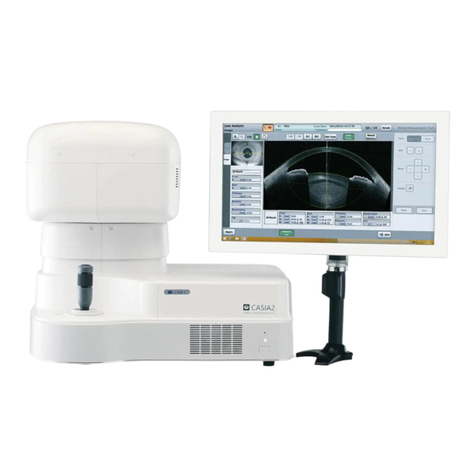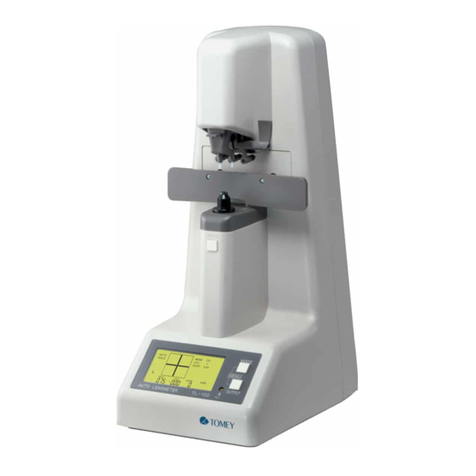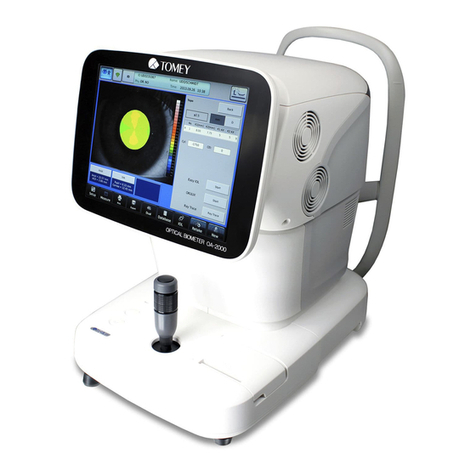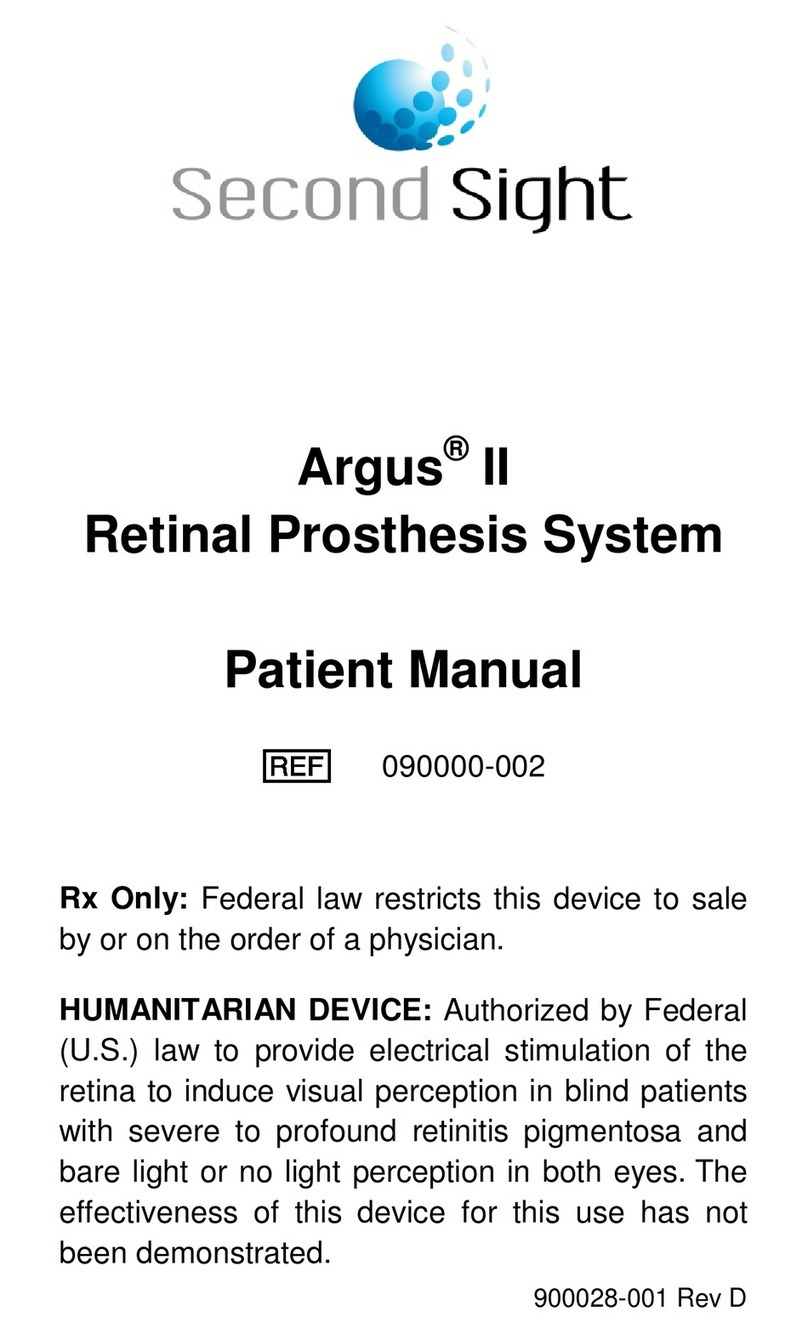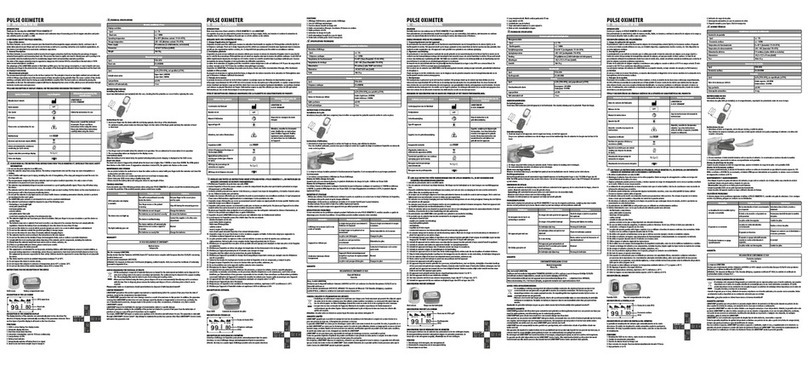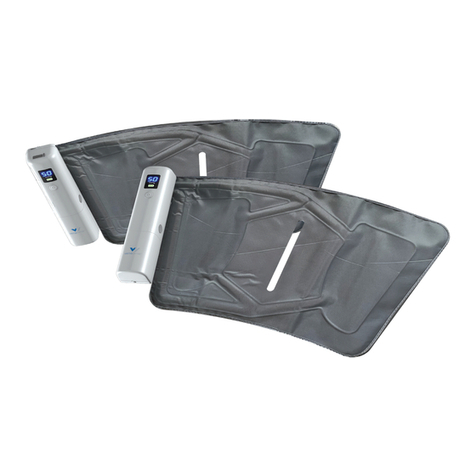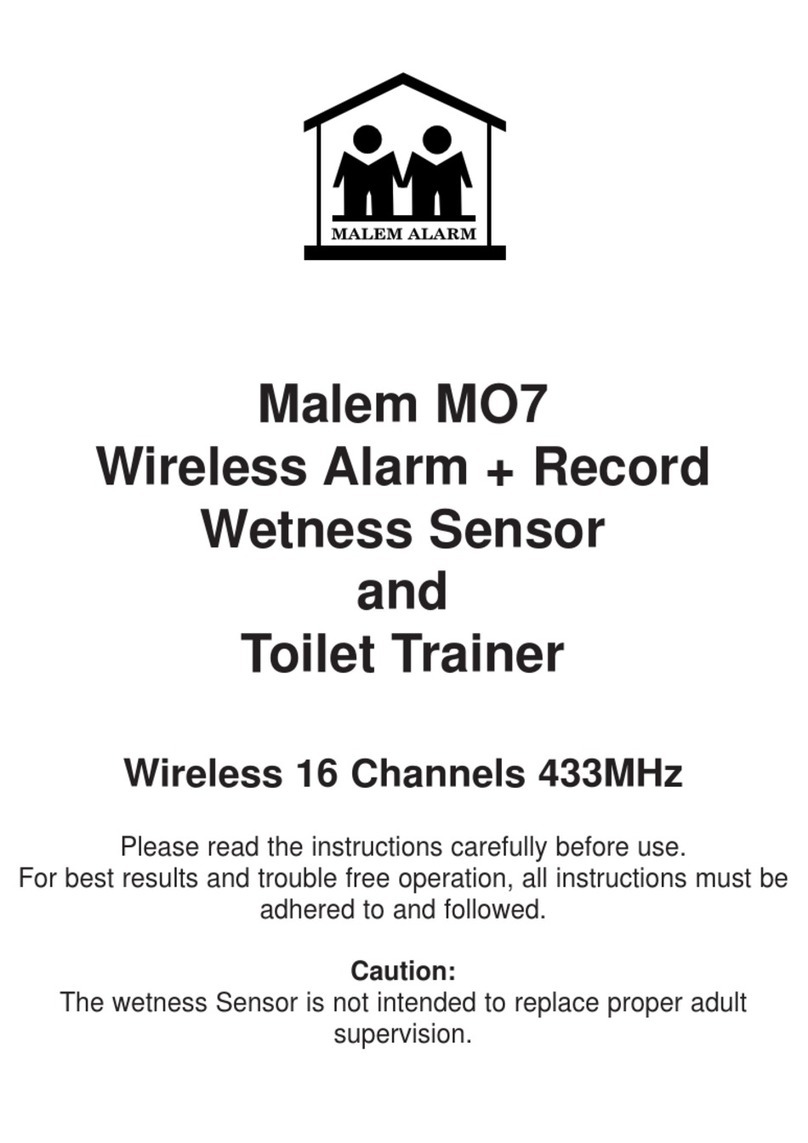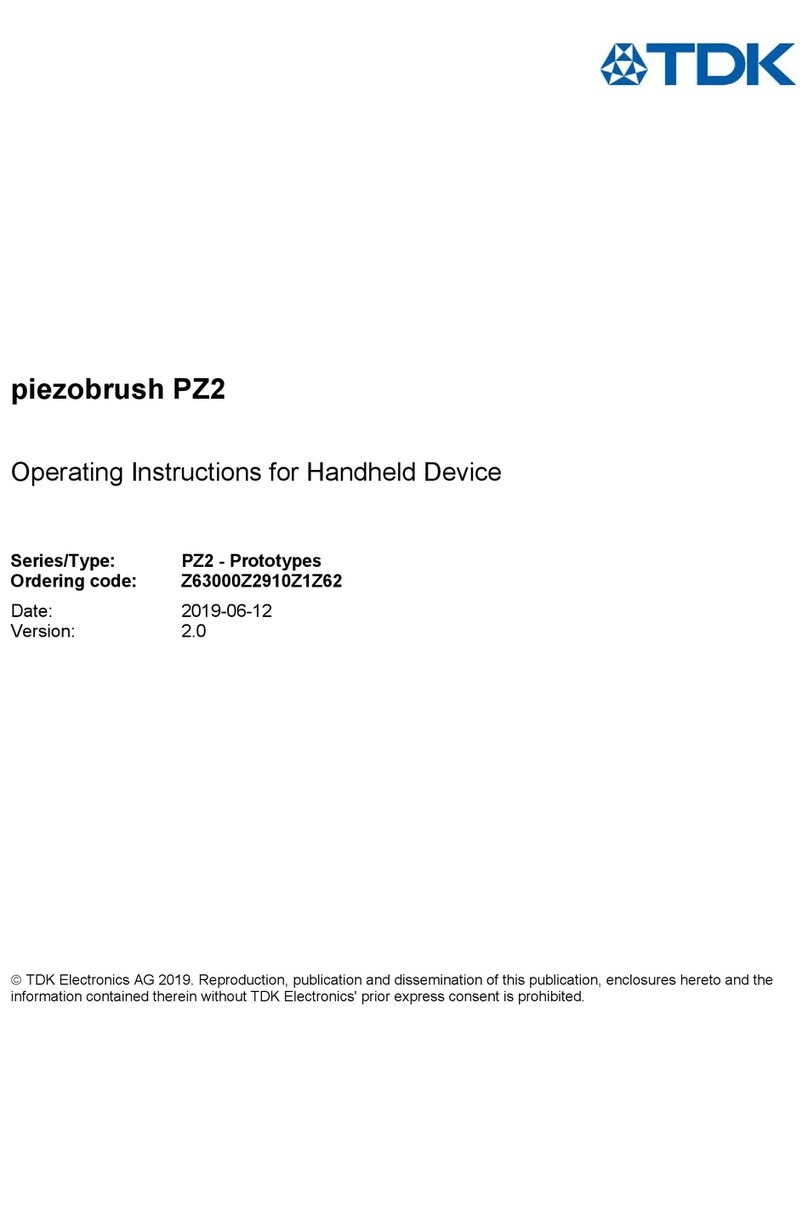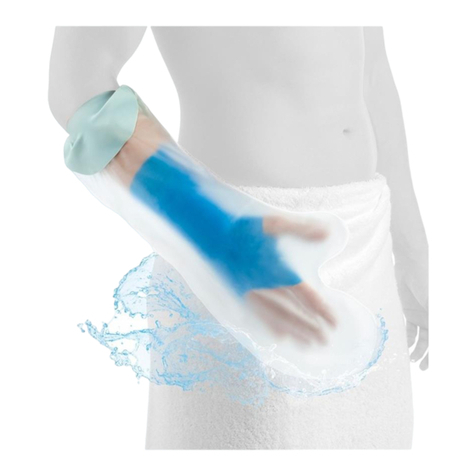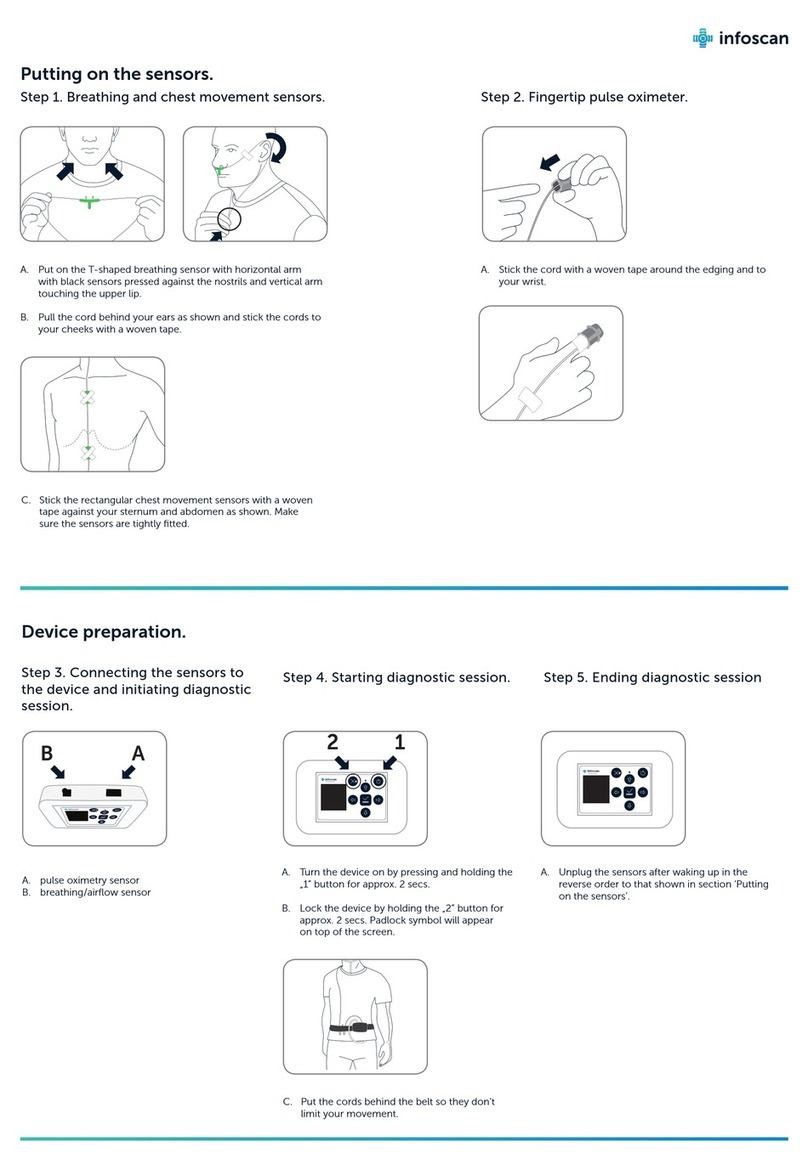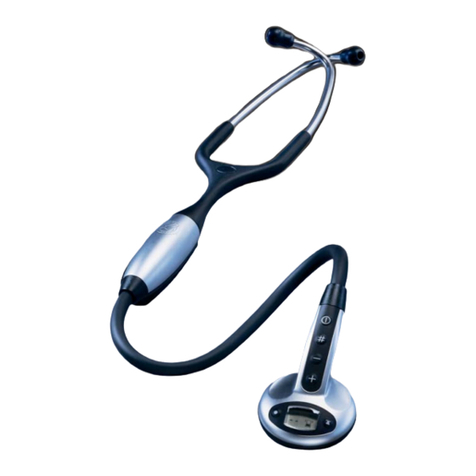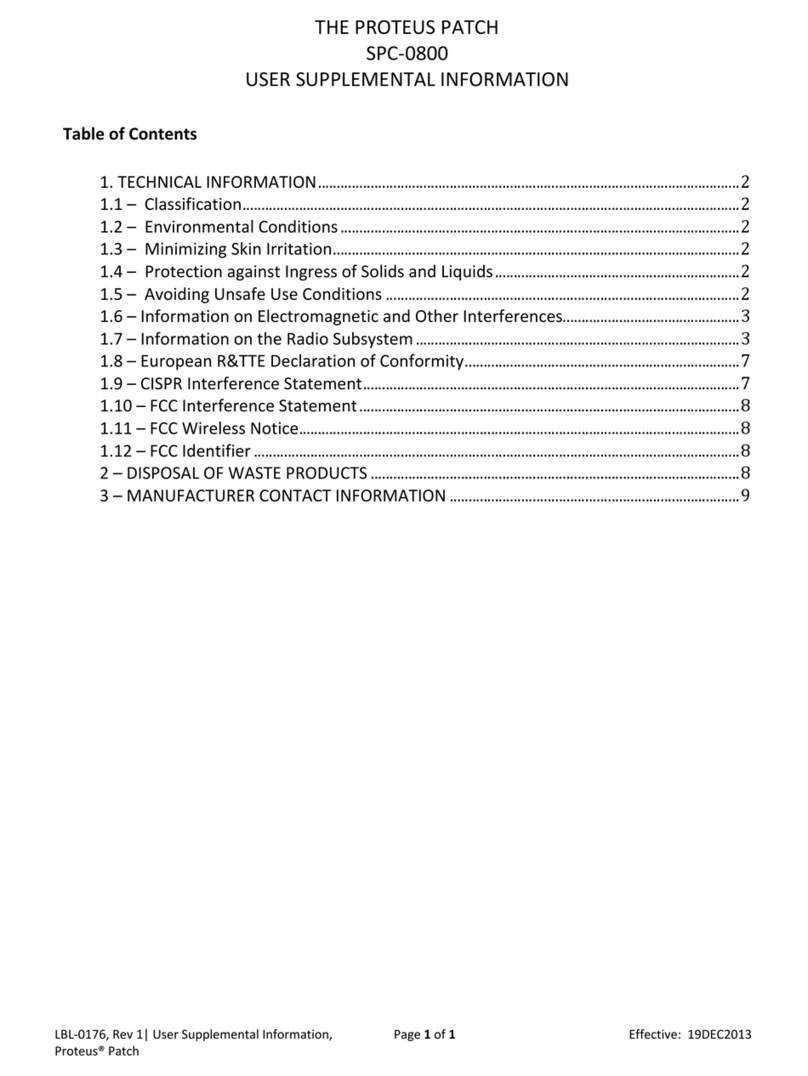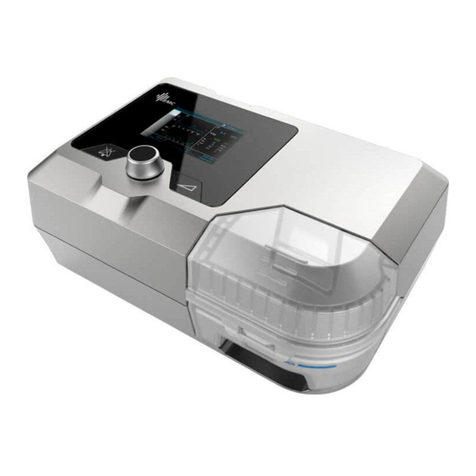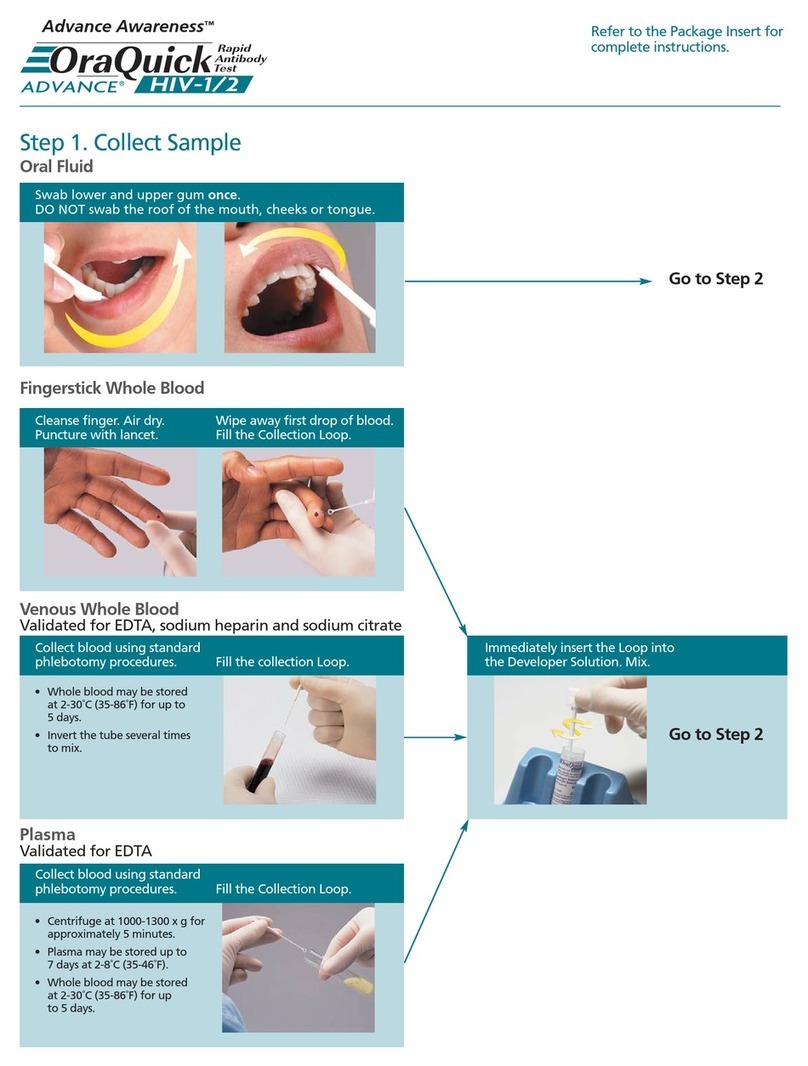Tomey SP-100 User manual

OPERATION MANUAL
HANDY PACHYMETER
SP-100
Read this Operation Manual carefully before using the SP-100 for proper and safe operation.
If you come up any questions about this instrument or the Manual, ask your Tomey represen-
tative or local distributor.
yy
yy
yDo not use this instrument by any procedures other than those specified in this
Manual.
yy
yy
yOnly well-trained or skilled personnel is allowed to operate this instrument.
yy
yy
yKeep the Operation Manual in a place where you can easily access while operating
the instrument.


i
WARNINGS
DO NOT USE THE INSTRUMENT WITH THE OUTER COVER AS LEFT
OPEN OR REMOVED, otherwise you may be exposed to direct high voltage.
Always use the sterilized or disinfected Pachymeter Probes for measurement.
NEVER USE the Probe if it may be subjected to any visible damage on its tip.
Such use may not only cause an incorrect measurement, but also damage the
cornea.
This instrument is designed exclusively for ophthalmic use.
DO NOT USE the instrument for any purpose other than ophthalmic use.
DO NOT connect the terminals of the instrument with any cable other than
those specified in the Manual, otherwise the instrument may be damaged.
SIGNIFICANT WARNINGS

ii
HOW TO USE THIS OPERATION MANUAL
THE COMPOSITION OF THE OPERATION MANUAL
The following items are provided for your efficient and effective use of
this instrument.
The Operation Manual is composed of the following parts.
1. PRIOR TO USE
Precaution and confirmation items related to the installation and us-
age of the instrument.
2. NAMES AND FUNCTIONS OF THE COMONENTS
Names and functions of the components of the instrument
3. OPERATING PROCEDURES
Vital information, required for installing and using the instrument
4. TECHNICAL INFORMATION
Useful technical information, which may be convenient for your use
5. MAINENANCE AND INSPECTION
Routine replacement, maintenance, and inspection, including replac-
ing spare parts
6. TROUBLESHOOTING
Countermeasures for troubles
7. SPARE PARTS AND OPTIONAL PARTS
Accessories and optional parts
8. SPECIFICATIONS
Specifications for the instrument
9. INDEX
Refer to the index as a guide, if necessary.
HOW TO USE THIS OPERATION MANUAL

iii
SYMBOLS USED IN THE MANUAL
SYMBOLS USED IN THE MANUAL
The symbols, such as "DANGER", "WARNING", "CAUTION" and "NOTE" used in this
Operation Manual, represent the following messages.
Precaution for an operation state that, if unheeded, will cause a haz-
ardous situation where there is an imminent danger of serious injury
or death.
Precaution for an operation state that, if unheeded, may cause a haz-
ardous situation where there is the possibility of serious injuries or
death.
An operational precaution that, if unheeded, may cause or lead to
minor or moderate injuries or property damages.
Special precaution that is related either directly or indirectly to per-
sonal safety or to property protection.

iv CONTENTS
Contents
1. PRIOR TO USE ............................................................................................................. 1-1
1.1 Precautions..................................................................................................................................... 1-1
1.2 Unpacking ...................................................................................................................................... 1-3
1.3 Symbols, used in this manual ........................................................................................................ 1-4
1.4 Outline of Measurement Principle .................................................................................................. 1-5
2. NAMES AND FUNCTIONS OF THE COMPONENTS ................................................... 2-1
2.1 Front and Right side of Main Unit ................................................................................................... 2-1
2.2 Rear and left side of Main Unit ....................................................................................................... 2-1
2.3 Operation Keys .............................................................................................................................. 2-2
3. OPERATING PROCEDURES ........................................................................................ 3-1
3.1 Safety precautions.......................................................................................................................... 3-1
3.2 Preparation before operation ......................................................................................................... 3-2
3.2.1 Connection of accessories ........................................................................................... 3-2
3.2.2 Disinfection of the probe............................................................................................... 3-2
3.2.3 Optional components ................................................................................................... 3-3
3.3 Adjustment and Setting .................................................................................................................. 3-4
3.3.1 Main power on and screen adjustment ........................................................................ 3-4
3.3.2 Startup Display .............................................................................................................. 3-5
3.3.3 Screen Contents ........................................................................................................... 3-7
3.3.4 Measuring conditions ................................................................................................... 3-9
3.4 Preparation for measurement ........................................................................................................3-12
3.4.1 Calibration of the Probe ...............................................................................................3-12
3.4.2 Operation Check ..........................................................................................................3-13
3.4.3 Measurement Preparation for Patient ..........................................................................3-13
3.5 Measurement.................................................................................................................................3-14
3.5.1 Single measurement....................................................................................................3-15
3.5.2 Delete Each Data Reading .......................................................................................... 3-16
3.5.3 Delete Data (Eye by eye or patient by patient) ...........................................................3-17
3.6 Printout ...........................................................................................................................................3-19
3.6.1 How to Printout the data ...............................................................................................3-19
3.6.2 Description of Printout ..................................................................................................3-20
3.6.3 IOP Calculation Printout ...............................................................................................3-21
3.7 Menu ..............................................................................................................................................3-22
3.7.1 Description of the Screen display ...............................................................................3-22
3.7.2 Operation for the MENU Screen ..................................................................................3-23
3.7.3 Operating procedures of the Menu Screen ................................................................3-24

v
CONTENTS
3.7.4 IOP Calculation ............................................................................................................. 3-29
3.8 Sending and receiving data ..........................................................................................................3-32
3.8.1 How to connect the serial communication cable ......................................................... 3-32
3.8.2 Setting of communication conditions ...........................................................................3-33
3.8.3 Data Export .................................................................................................................. 3-35
3.8.4 Data Receiving.............................................................................................................3-37
3.9 Data Management with TOMEY Link (Electronic Modical Record Support System) ...................3-39
3.9.1 Patient Data Receiving.................................................................................................3-39
3.9.2 Data Sending ............................................................................................................... 3-41
3.10 Battery ...........................................................................................................................................3-43
3.10.1 Battery charge balance ................................................................................................3-43
3.10.2 Low Battery Warning ....................................................................................................3-44
3.10.3 Charge indicator ........................................................................................................... 3-45
3.10.4 How to Install / Uninstall Battery ...................................................................................3-45
3.10.5 Lifetime of rechargeable battery ..................................................................................3-46
3.10.6 Expected operating time of hours ...............................................................................3-46
4. REFERENCE TECHNICAL INFORMATION .................................................................. 4-1
4.1 How to calculate corneal thickness ................................................................................................ 4-1
4.2 Acoustic Output .............................................................................................................................. 4-1
4.2.1 MI (Mechanical Index) ....................................................................................................... 4-1
4.2.2 TIS (Soft Tissue Thermal Index) ........................................................................................ 4-1
5. MAINTENANCE AND INSPECTION .............................................................................. 5-1
5.1 Warranty .......................................................................................................................................... 5-1
5.2 Routine maintenance ...................................................................................................................... 5-2
5.2.1 Measurement Probe ..................................................................................................... 5-2
5.2.2 Maintenance of the Main Unit ........................................................................................ 5-4
5.3 Replacing of the printer paper ....................................................................................................... 5-5
5.4 Storage ........................................................................................................................................... 5-6
5.5 Precautions for disposal of packing materials ............................................................................... 5-6
6. TROUBLESHOOTING ................................................................................................... 6-1
7. SPARE PARTS AND OPTIONAL PARTS ....................................................................... 7-1
7.1 Spare parts ..................................................................................................................................... 7-1
7.2 Optional parts ................................................................................................................................. 7-1
8. SPECIFICATIONS .......................................................................................................... 8-1
8.1 Specifications ................................................................................................................................. 8-1
8.1.1 Measuring function ........................................................................................................ 8-1
8.1.2 Measuring Probe .......................................................................................................... 8-1

vi CONTENTS
8.1.3 Main unit ........................................................................................................................ 8-1
8.1.4 AC Adapter ................................................................................................................... 8-1
8.1.5 Enclosed battery........................................................................................................... 8-1
8.2 Ultrasound energy and other information ....................................................................................... 8-2
8.2.1 Influences of ultrasound energy on the human body ................................................... 8-2
8.2.2 Ultrasound energy ........................................................................................................ 8-2
8.3 Noise Generation ........................................................................................................................... 8-4
8.4 Operating Environment................................................................................................................... 8-4
8.5 Conformed Standard ...................................................................................................................... 8-4
9. INDEX ............................................................................................................................ A-1

1-1
1. PRIOR TO USE
Make sure that the instrument is free from any equipment
that may cause an intensive magnetic field, which other-
wise causes the instrument with noises or may make it
unable to allow correct diagnosis or measurement.
Care must be taken not to place any object on the instru-
ment.
Be sure to read this Manual before using the instrument
for your safe and correct operation.
Do not use the instrument in any procedures other than
specified in this Manual.
1.1 Precautions
Though measuring accuracy is +/- 5
µµ
µµ
µ
m, accuracy with actual
measurement may be out of the measuring accuracy, depending on
condition of cornea. Please review and retake the measurement or try
other inspections, when the result seems to be suspicious with past
corneal medical history of the patient.
Only skilled operators are allowed to use this instrument.
When installing the instrument, observe the following items.
-Install the instrument in a place where it is free from water and/or
chemicals.
-Install the instrument in a place where it is free from such adverse
influences as direct sunbeams, high temperature and moisture, dust, and
salts or sulfur-contained air.
-Install the instrument in a stable place where it is free from inclination,
vibration, and/or shocks.
-Do not install the instrument in or near the store area of chemical
substances or a place where any gas is generated.
-Use specified frequency, voltage and allowable current (or allowable
power consumption).
-Make sure that the conditions of power source (discharge, polarity, etc)
are proper.
1.1 Using precautions

1-2
Observe the following items before using the instrument.
-Check on the settings of switch connections, polarity, and volumes and
make sure that the instrument operates accurately.
-Make sure that all the cord connections are made properly.
-Recheck the components or parts that directly touch the Patient.
Observe the following items when you use the instrument.
-Avoid using an excessive period of measurement for each Patient.
-Closely and continuously watch to check to see if the instrument works in
normal condition and the Patient is secured in safe condition.
-If any abnormal condition is found with the instrument or the Patient,
take appropriate actions or remedy, first to secure Patient's safety and
next to stop the operation of the instrument.
-Sufficient care should be given not to cause the Patient to touch the
instrument while the instrument is in operation.
Observe the following items after using the instrument.
-Before turning the power off, return the instrument to its original
condition in specified procedure.
-Do not apply undue force to the power cable when disconnecting, such as
by pulling the cord itself.
-As for storing the instrument and related components, see "5.4 Storage"
in this Manual.
-Store the Pachymeter Probe, accessories, and cords in order after
cleaning them properly.
-Be sure to properly clean the instrument to be ready for your next use.
It is advised that in case the instrument is disorderd, stop using the
instrument and contact your TOMEY representative for corrective
inspection and/or repair.
Do not uncover except battery cover or remodel the main instrument in
any ways.
Do not remodel or redesign the instrument, or the Warranty will be
invalid.
Periodical inspection should be given to the instrument and related
components.
When using the instrument after recess for a while, make sure that it
operates properly and safely.
Please USE AC power adapter provided from TOMEY as SP-100
standard accessory. When using other AC power adapters, the warranty
will be invalid and the unit may not work properly.
1.1 Using precautions

1-3
1.2 Unpacking
Make sure, when unpacking the shipment, the instrument, including probe and
supplies all arrived at your place in their proper conditions. Check these com-
modities on any damages and malfunctions.
Be sure to keep all the shipping and packing materials,
which may be used when the instrument is moved to the
other place.
zMain unit, HANDY PACHYMETER SP-100
(Lithium-Ion Battery Included) ....................................... 1
zPachymeter Probe
(with the protective cap and the case) ......................... 1
zPachymeter test piece .................................................... 1
zAC adapter ................................................................... 1
zPrinter paper roll (1 roll in the instrument) ....................... 3
zSerial communication terminal protective cap .................. 1
zOperation Manual (this manual) ...................................... 1
zCarryingBag ................................................................. 1
zInner Case ..................................................................... 1
zQuick Guide .................................................................. 1
1.2 Unpacking

1-4 1.3 Symbols used in this manual
1.3 Symbols, used in this manual
The terms and symbols, used for the instrument, shall imply the following means.
PROBE Pachymeter probe terminal
Connects the Probe to this terminal.
Power Switch
Turns main power ON and OFF.
Contrast adjusting volume
Adjusts the contrast of the monitor
Serial communication terminal
Various data is sent and received through the external
by using the serial communication cable.
Maintenance switch
This switch should be used for maintenance purpose only
Do not touch this switch for changing.
AC adapter terminal
Connects the AC adapter, included in the box.

1-5
1.4 Outline of Measurement Principle
1.4 Outline of Measurement Principle
After taking measurement, the oscillator is not emitting
ultrasound waves.
The SP-100 is designed for pachymeter or corneal thickness measurement by
using ultrasound transducer, built in Pachymeter probe.
zSP-100 emits the ultrasound from the Pachymeter probe and the
probe also receives the ultrasound reflected by surface between
corneal posterior face and anterior chamber.
zSP-100 measures the period of time from emitting ultrasound to
receiving the same ultrasound, reflected by corneal posterior part.
Applying a calculation formula shown below, corneal thickness
can be calculated.
L= ———
Where, L: Corneal Thickness
V: Converted sound velocity
(Ultrasound Velocity through cornea)
T: Measured time (Ultrasound transmission
time between emitting and receiving)
zThis instrument is powered by rechargeable battery or AC power
adapter. Even when the battery power is running short, SP-100
can perform measurements, while charging the battery, by plug-
ging to AC power adapter.
zThis instrument is designed to take corneal thickness measure-
ment automatically, when the probe is applied to cornea properly.
zThis instrument is capable of sending and receiving patient infor-
mation and measurement data between the external equipment
through the serial communication port. (Additional cable must be
used, when using this function)
V · t
2

1-6
This page is left intentionary blank.

2-1
2. NAMES AND FUNCTIONS OF THE COMPONENTS
2.1 Front and Right side of Main Unit
AA
AA
ASCREEN
Measurement data and other information can be
displayed.
B B
B B
B OPERATING PANEL
The keys are located on the panel with various
functions.
CC
CC
CPACHYMETER PROBE TERMINAL
Pachymeter Probe should be connected to this
terminal.
DD
DD
DSERIAL COMMUNICATION TERMINAL
Serial Communication Cable can be connected
for data communication.
EE
EE
EAC ADAPTER TERMINAL
AC Adapter can be connected for supplying
power for operation and charging battery.
FF
FF
FPROBE HOLDER
Pachymeter Probe can be hold and kept as stable
position. Use the holder, while the probe is not
in use.
GG
GG
GBUILT-IN THERMAL PRINTER
Patient and Measurement information can be
printed by selected Standard or Simple mode.
2.2 Rear and left side of Main Unit
AA
AA
AINSTRUMENT STAND
The main unit stands on desk tilted for easy op-
eration and monitoring.
BB
BB
BCONTRAST VOLUME DIAL
LCD contrast can be adjusted.
CC
CC
CMAINTENANCE SWITCH
This Switch is for maintenance use only. DO
NOT change any setting this switch, or the unit
is damaged.
2.1 Front and Right side of Main Unit 2.2 Rear and left side of Main Unit

2-2
2.3 Operation Keys
General key assignments are explained in this part. However, other functions
are assigned on the same key, depending on the screen. Read each part of the
manual carefully in order to understand the key operation completely.
AA
AA
AFUNCTION KEYS
Each key works as assigned function shown on
the bottom of the screen. Four boxes from left
to right on screen indicate each function of F1,
F2, F3 and F4 keys.
BB
BB
BPRINT KEY
Patient and Measurement Data can be printed
by built-in thermal paper. Please refer to [3.6
Printout] for details.
CC
CC
CWW
WW
W, XX
XX
XKEYS
Data selection, Patient ID & Name can be typed
in by using the keys. Press both keys simulta-
neously to turn LED ON and OFF. (When the
unit is only powered by battry and no operation
for one minute, it automatically turns LED off)
DD
DD
DCHARGE INDICATOR
The light keeps turning ON, while charging the
internal battery. When it turns OFF, charging
battery is completed.
EE
EE
EPOWER KEY
The main power turns ON and OFF. When the
unit is only powered by battery and no opera-
tion for three minutes, it automatically turns OFF
to save battery power. (Auto Power OFF)
(F-keys Example) Each key, on this page, is assigned its func-
tion as follows:
xF1 ........... R/L
xF2 ........... INDEX
xF3 ........... EDIT
xF4. .......... NEW
2.3 Operation Keys
(Example)

3-1
3. OPERATING PROCEDURES
3.1 Safety precautions
The Probe must always be disinfected before its use.
Never use the Probe, if there is any visible damage on its tip, which may
otherwise cause an incorrect measurement or damage the cornea.
This instrument is Ophthalmic Medical Device, designed for only skilled
operators.
-Do not use this instrument other than Ophthalmic applies.
Do not use any terminal other than specified in this Operation Manual,
which may otherwise cause to damage the instrument.
Do not leave the instrument plugged with the AC Adapter when the
battery is fully charged, otherwise, this may enshorten the lifetime of
built-in rechargeable battery.
When the probe is not in use, please place the probe cap and place the
probe to the holder to protect from getting damaged.
3.1 Safety precautions

3-2
3.2 Preparation before operation
3.2.1 Connection of accessories
a) Connection of Pachymeter Probe
Connector of the Probe should be inserted in speci-
fied direction. Insert the connector as deep as it
sounds "click".
Insert the connector Ainto the connecting terminal B
marked "PROBE" on the front side of Main Unit.
b) Connection of AC Adapter
Insert the connector to the terminal completely
Insert AC adapter connector Ainto the connecting termi-
nal Bprovided on the right side of the Unit.
3.2.2 Disinfectionofthe probe
Disinfect the probe with proper procedure, before its use. Please
refer to [5.2.2 Disinfecting Pachymeter Probe] for details.
3.2 Preparation before operation

3-3
3.2.3 Optional components
Assembling of the Disposal Tip Pachymeter Probe and alternative Probe shapes
The Disposal Type Pachymeter Probe (supplied as
an optional component) consists of the inner probe,
case, fixed ring, and disposal tip.
The Probe can be changed in two alternative shapes:
(A) with 45 shape and (B) in straight shape, de-
pending on the application convenience.
<How to assemble>
1) Cover the inner probe Awith a pair of cases
Bto make the inner probe clipped in between
and fix it with the rubber rings C.
2) Apply a small amount of methylcellulose (such
as Dry Eye Gel) on the tip of the inner probe
A.
3) Then securely insert the disposal tip Dnot to
cause air bubbles inside of the tip.
<How to assemble the Probe in alternative shape>
1) Disassemble the disposal tip D, fixed ring C,
and the case Bin order.
2) Assemble the case Bto be changed and next
fix it with the rings C.
3) Next apply a small amount of methylcellulose
to the tip of the inner probe.
4) Then securely insert the disposal tip Dnot to
cause air bubbles inside of the tip.
3.2 Preparation before operation

3-4
3.3 Adjustment and Setting
3.3.1 Main power on and screen adjustment
Confirm the following items before turning the power on.
xx
xx
xMake sure the battery is sufficiently charged. If not, con-
nect the AC adapter for power supply. (With battery opera-
tion and 3 minutes of non operating time, the unit goes
into Auto Power off mode and measured data will be lost)
xx
xx
xMake sure the Probe has been connected.
xx
xx
xMake sure the tip of the Probe is dry.
Tilt the LCD screen on the proper position in order to get bet-
ter view from the front
1) Press the power key Ato start operation. The
instrument will automatically calibrate the con-
nected Probe. If "PROBE ERROR!" is displayed
on the screen, check if the tip of the Probe is dry.
(Refer to [3.3.2 Startup Display] for details)
2) Adjust the LCD contrast, according to the
brightness of the clinical room by using con-
trast adjusting dial Bon the left side of the
unit.
When the room is dark, press the "W" and "X"
keys Csimultaneously to turn the lighting LED
on.
3) Adjust Instrument Stand Don back of the unit to
tilt it to get better screen view.
Ԙ
( ( ( (
24+06
.+)*6
219'4
%*#4)'
*#0&;
2#%*;/'6'452
3.3 Adjustment and Setting
(Fig. 1)
(Fig. 2)
(Fig. 3)
Other manuals for SP-100
1
Table of contents
Other Tomey Medical Equipment manuals
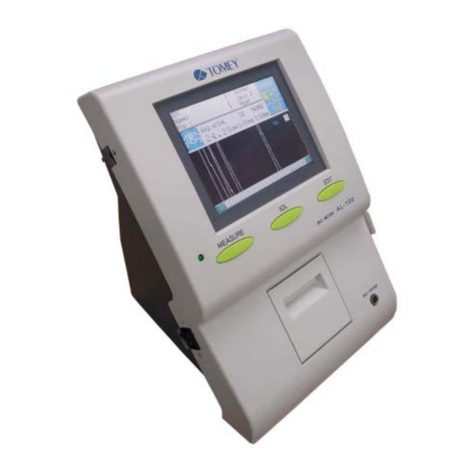
Tomey
Tomey AL-100 User manual
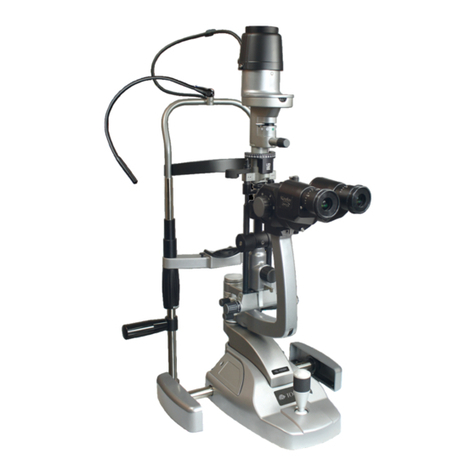
Tomey
Tomey H Series User manual

Tomey
Tomey H Series User manual
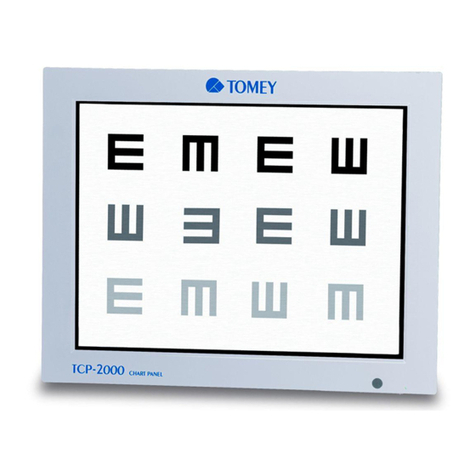
Tomey
Tomey TCP-2000 User manual
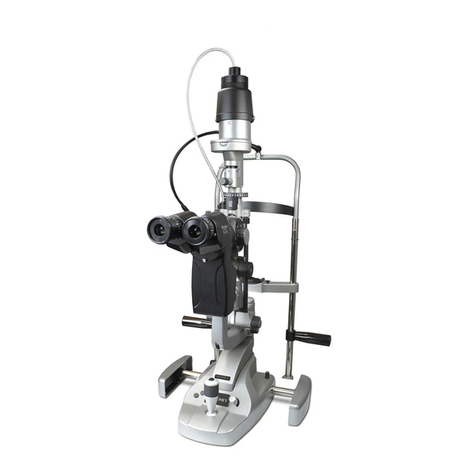
Tomey
Tomey TSL-7000Hdigital User manual
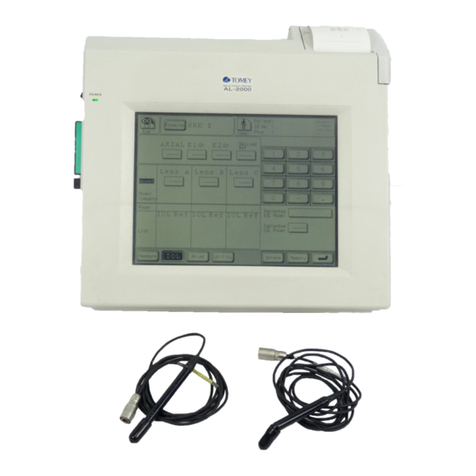
Tomey
Tomey AL-2000 User manual
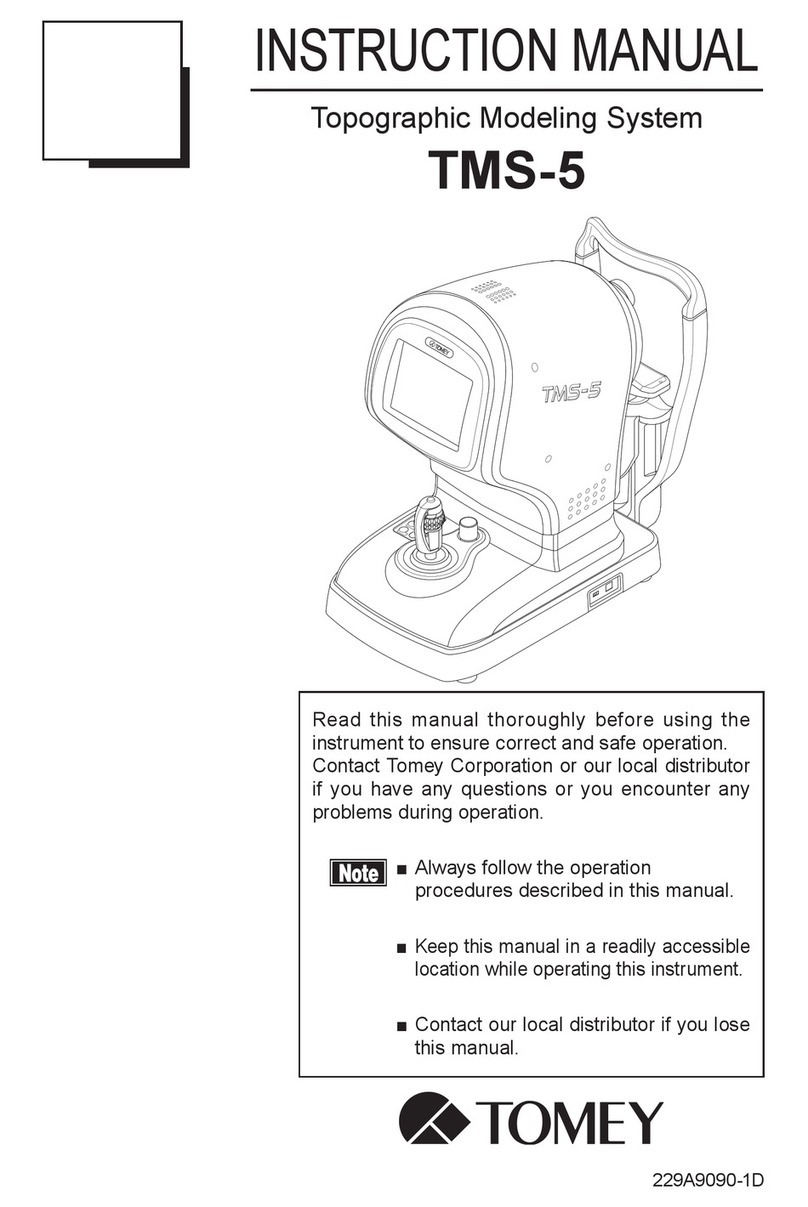
Tomey
Tomey TMS-5 User manual
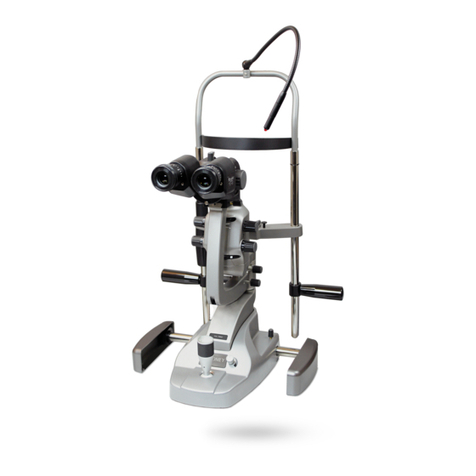
Tomey
Tomey Z Series User manual
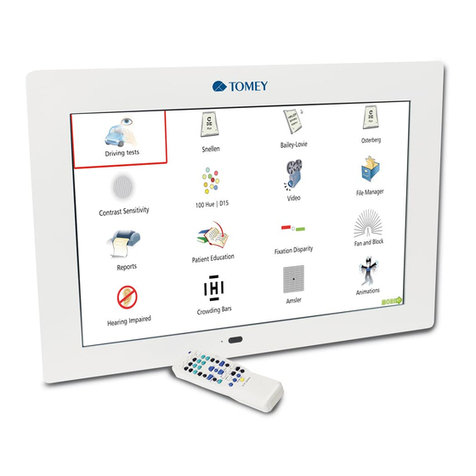
Tomey
Tomey TCP-2000P User manual
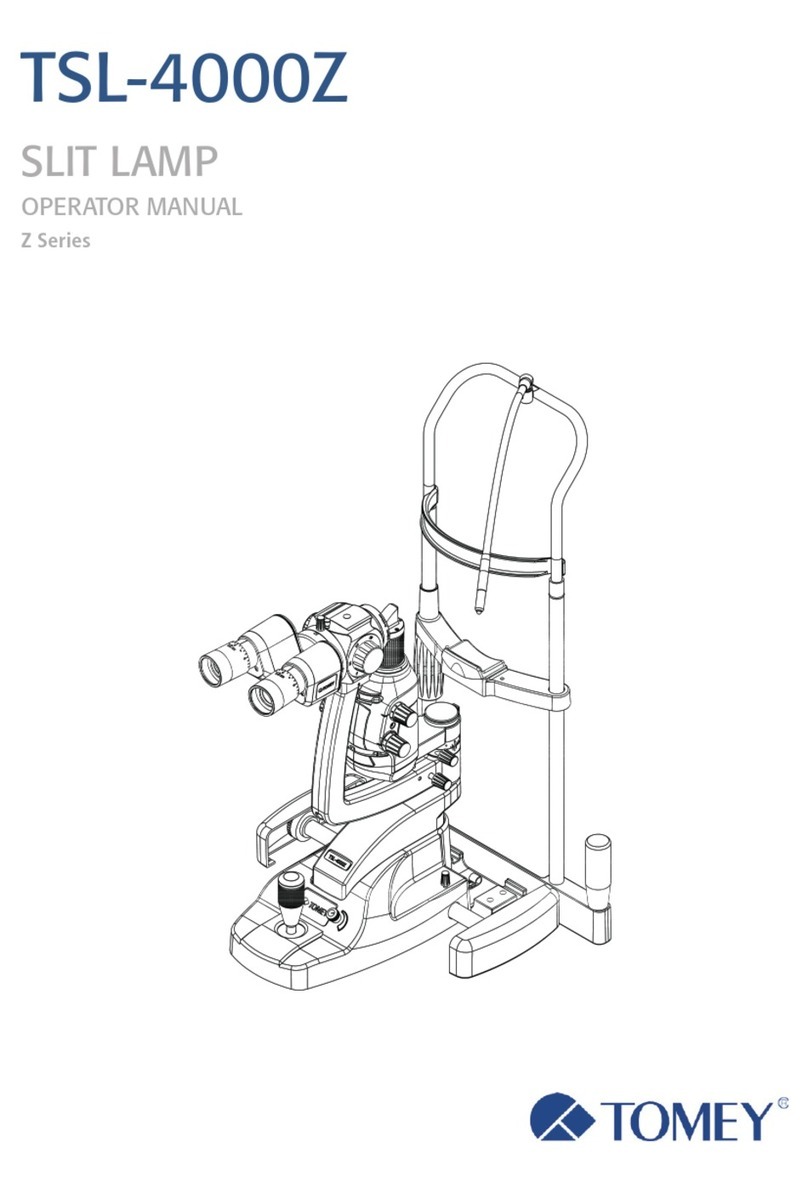
Tomey
Tomey TSL-4000Z User manual
